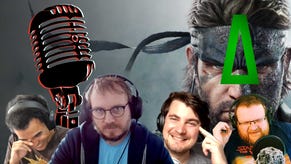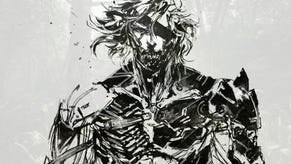Metal Gear Rising Revengeance: lightning strikes twice
Metal Gear Rising: Revengeance, once a troubled project, is back from the brink thanks to co-developer Platinum Games. VG247's Dave Cook speaks with Yuji Korekado regarding the new direction.
Originally announced in 2009, Rising's main hook was the ability to cut anything with Raiden's high frequency blade. The premise was sound, but the game's core concept was far removed from the stealth focus of Kojima's Metal Gear Solid saga. As a result, fan opinion became split.
It's from this point that the events surrounding Metal Gear Rising become hazy, and the decision was eventually made to halt production. Then came an odd descent into radio silence that began shortly after Kojima Productions released several teaser trailers that gave insight into the game's key mechanics.
The studio gave us a glimpse of Raiden's Blade Mode in action as he diced up enemies and the environment into tiny chunks. The notion of Zan-Datsu – 'cut and take' – saw Raiden slicing up foes and then taking their cybernetic body parts to progress. It seemed to be coming together so well, and then, nothing.
"Platinum are in control of game development, but direction for the world, the story and cutscenes are all handled by Kojima Productions. We talk on a daily basis to make sure that story reflects on gameplay."
But at the 2011 Spike TV Awards, Metal Gear Rising rose again – this time as the vibrant and animated Revengeance, co-developed by hack n' slash veterans Platinum Games. With team pedigree that spans the likes of Devil May Cry and Bayonetta, the choice of studio makes sense given Platinum's glittering track record within the genre.
Creative producer at Kojima Productions Yuji Korekado was sold on Platinum from day one, and stressed to us that Kojima's studio was unanimous in its decision, “When we were developing this title internally – at some point – the decision came to give development over to another studio.”
“At that point Kojima said that in Rising, one of the key features is the katana, so it had to be a Japanese developer that worked on it. So then we started looking at Japanese studios who had experience in action games, and of course Platinum Games came to mind”, Korekado added.
“They had great titles such as Vanquish and Bayonetta,” Korekado continued, “So we approached them, and they were happy to become involved.” However, Platinum Games wouldn't just be included to finish the work Kojima's team had started. Instead, the studio wanted to begin from scratch – save for a few thematic and gameplay values.
It was a big request for Korekado's team but he revealed that it made sense to both him and Kojima, “Originally we had the game built to a certain point. We had a story, we had characters and boss battles.”
“But when we first approached Platinum Games,” Korekado added, “the director, producer and whole development team said, 'Well, please let us start from scratch with the story, characters and boss battles. We know it's asking a lot but it will be something you will really like.'”
From a development standpoint this actually made sense, because if a game's handling, story and scenarios feel disjointed, then the whole package feels weaker as a result. Cobbling together two halves of projects created by two entirely different teams could have been disastrous for both parties.
“As far as game design goes,” Karekdo adds, “If we want to make a really good product, the design aspect must relate to gameplay and vice-versa.” While it was never clear what the overall plot of the original Rising entailed, Platinum's angle feels right.
Once a child soldier raised in war and brainwashed to be a ruthless killer, Raiden's origins are ripe for exploration. Kojima has always stated that Rising is not canon, but this clean slate didn't result in Platinum having complete freedom over the game's world.
Korekado explained, “Platinum are in control of game development, but direction for the world, the story and cutscenes are all handled by Kojima Productions. We talk on a daily basis to make sure that story reflects on gameplay.”
Speaking of gameplay, actually sitting down to play Rising and tearing up enemies as Raiden reveals it to share many traits with Platinum's Bayonetta. Speed, deep combo potential and difficulty are paramount - backed up by the same dizzying spectacle and ferocity of Vanquish.
Combat starts small, with simple slashes and jabs that give rise to kicks, launchers, juggles and of course Blade Mode. Hitting L2 will slow down time and present the payer with a cut marker. Simple use both analogue stick to position Raiden's strike and release to being slicing enemies apart.
Where most games within this genre have combo counters, Rising has meters for hits, parts – as in, how many parts you have sliced enemies into – and kills. Hitting those top ranks isn't going to be easy, but it's the same kind of challenge Bayonetta presented, although slightly more intimidating this time.
The promise of having freedom to cut anything was ambitious at the outset, Korekado admitted, “When we started working on the game, the free-cutting notion was the idea that you can cut through enemies, walls, objects – anything. We wanted to give this freedom, but if you were able to cut anything, the game design would quickly become destroyed.”
“If you were able to cut through all of the buildings there would be no need to hide,” Korekado continued, “There would be no obstacles in the game, and so we had to really think about what you could and couldn't cut.”
Rising is a project that puts a new spin on an existing franchise that millions of gamers know and relate to.
Blade Mode is a carry-over from Kojima Productions' time spent with the project, but it's interesting to see what Platinum's expertise brought to the table. Korekado explained, “Platinum make great action games, and the combo system they used is very deep, so there are a lot of combat moves in Metal Gear Rising”
“There's a also a move called Ninja Run that Raiden can use to run up walls and reach high hiding spots, or to get close to enemies before they notice and attack,” Korekado added. So there is stealth in Metal Gear Rising, but it's a predatory slant the studio has dubbed 'Hunting Stealth.'
While playing Metal Gear Rising: Revengeance, there is an overall feeling that everything is the same but different. Familiar sounds, HUD markers, codec calls, voices, faces and names all tenuously tether Rising to the core series, but it is still a gamble for both Kojima Productions and Platinum Games.
Rising is a project that puts a new spin on an existing franchise that millions of gamers know and relate to. Regardless, Kojima has mentioned Rising's franchise potential before, but only if fan demand is there.
Korekado didn't know about this when we asked him, with a surprised shout of, “Really?” before laughing at Kojima's tease. But he agreed that it may well happen, “As a creator, when you're making a game one of your goals is that you want the people who play it to want more.”
“That's the same for Rising,” Korekado continued, “We want fans to play the game, finish it, then ask for more. If that voice grows bigger and if Kojima gives it the green light, then you may well see more of Raiden.”
Metal Gear Rising: Revengeance launches in February 19 in the US and Europe, followed by Japan on February 21 for PS3 and Xbox 360.









